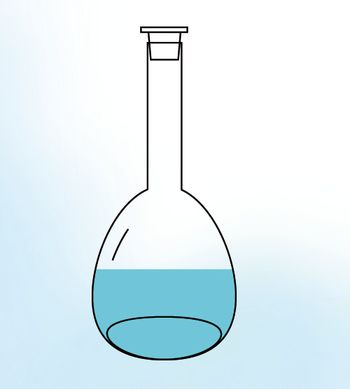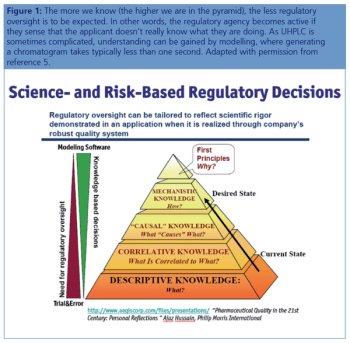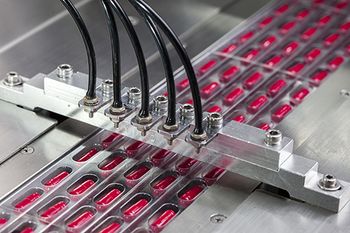
The Column
Incognito asks if chromatographers are behind the curve when it comes to automation.

The Column
Incognito asks if chromatographers are behind the curve when it comes to automation.

The Column
Two-dimensional liquid chromatography (2D-LC) is drawn out of the chromatographic toolbox if resolution for compounds of interest is insufficient. Recently, several studies have started to highlight 2D-LC as a tool of choice to streamline analytical workflows to increase automation making them less time-consuming. This article highlights two proven cases where 2D-LC does more than simply increase peak capacity.

The Column
Liquid chromatography–mass spectrometry (LC–MS) platforms are continually developing to offer improved sensitivity to meet the analytical demands of today’s laboratories. However, choosing an inappropriate solvent can significantly undermine the quality of results, even when using the most advanced technology; a high-purity mobile phase with excellent batch-to-batch consistency is essential for reliable and reproducible results. This article discusses the importance of selecting the correct grade of solvent for LC–MS analyses and some of the challenges arising from an insufficiently pure mobile phase.

The Column
Many workers in pharmaceutical laboratories are unable to change any aspect of their methods, although they often encounter severe problems and create many out-of-specification (OoS) results. They are particularly afraid to investigate these problems from a chromatographic perspective in case they generate new unforeseen problems. In the literature, however, there are numerous examples showing that it is worthwhile trying to understand the reasons for “unexplainable” behaviour in ultrahigh-pressure liquid chromatography (UHPLC) using modelling. By using modelling, problems can be recognized and often eliminated with legal operations according to the allowed tolerance limits mentioned in pharmacopoeia descriptions. The following article aims to show that “visual chromatographic modelling” can be a useful aid.

The Column
The key differences between a classical balance and currently available automated systems from the good weighing practice (GWP) perspective and within the scope of ISO9001:2015 quality standard are discussed. The systems under review are: (i) manual analytical balances; (ii) semi‑automatic systems; (iii) fully automatic systems; and (iv) integrated systems that use on-line coupling of the analytical balance with the instrument used for analytical measurements. The parameters defined in GWP guidelines, such as accuracy, uncertainty, minimum weight, and risks (including out‑of‑specification results), will be evaluated for all of these systems.

The Column
Researchers from Merck and Agilent Technologies have developed a simple and fast generic gas chromatography–flame ionization detection (GC–FID) method for the quantitation of volatile amines in pharmaceutical drugs and synthetic intermediates.

The Column
Agilent Technologies has announced that it has entered into a definitive agreement to acquire the privately held ProZyme, Inc., a provider of glycan analysis reagents, kits, and standards.

The Column
Hamilton Storage GmbH has announced the total relocation of its operations to a high-technology industrial park in Domat/Ems, Switzerland.

The Column
The Chromatographic Society has announced the “Grass Roots 3” Educational Event is to be held at the Waterhead Hotel, Ambleside, Cumbria, UK, Friday 5–Monday 8 October 2018.

The Column
Click the title above to open The Column July 2018 North American issue, Volume 14, Number 7, in an interactive PDF format.

The Column
Click the title above to open The Column July 2018 Europe & Asia issue, Volume 14, Number 7, in an interactive PDF format.

The Column
What type of mass spectrometry (MS) instrumentation provides the best specificity during trace quantitative analysis from complex mixtures?

The Column
This article describes a direct analysis of glyphosate, aminomethylphosphonic acid (AMPA), glufosinate, and 3-methylphosphinicopropionic acid (MPPA) in water by liquid chromatography coupled to tandem mass spectrometry (LC–MS/MS) without derivatization. The chromatographic separation was performed using a hydrophilic interaction liquid chromatography (HILIC) column and typical LC–MS mobile phases. Method performance was evaluated, showing excellent results. The low limits of quantification (LLOQs) obtained meet the requirements of EU guidelines and could also be used to get an agreement in France where regulations require lower LLOQs (NOR: DEVL1703763V).

The Column
This article describes a direct analysis of glyphosate, aminomethylphosphonic acid (AMPA), glufosinate, and 3-methylphosphinicopropionic acid (MPPA) in water by liquid chromatography coupled to tandem mass spectrometry (LC–MS/MS) without derivatization.